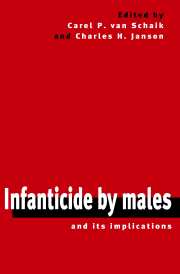Book contents
- Frontmatter
- Contents
- List of Contributors
- Foreword
- Infanticide by males: prospectus
- Part I Introduction
- Part II Infanticide by males: case studies
- 4 Infanticide in red howlers: female group size, male membership, and a possible link to folivory
- 5 Infanticide in hanuman langurs: social organization, male migration, and weaning age
- 6 Male infanticide and defense of infants in chacma baboons
- 7 Infanticide by males and female choice in wild Thomas's langurs
- 8 The evolution of infanticide in rodents: a comparative analysis
- 9 Infanticide by male birds
- Part III Behavioral consequences of infanticide by males
- Part IV Infanticide by females
- Part V Conclusion
- References
- Species index
- Subject index
5 - Infanticide in hanuman langurs: social organization, male migration, and weaning age
Published online by Cambridge University Press: 04 November 2009
- Frontmatter
- Contents
- List of Contributors
- Foreword
- Infanticide by males: prospectus
- Part I Introduction
- Part II Infanticide by males: case studies
- 4 Infanticide in red howlers: female group size, male membership, and a possible link to folivory
- 5 Infanticide in hanuman langurs: social organization, male migration, and weaning age
- 6 Male infanticide and defense of infants in chacma baboons
- 7 Infanticide by males and female choice in wild Thomas's langurs
- 8 The evolution of infanticide in rodents: a comparative analysis
- 9 Infanticide by male birds
- Part III Behavioral consequences of infanticide by males
- Part IV Infanticide by females
- Part V Conclusion
- References
- Species index
- Subject index
Summary
Introduction
Hanuman langurs (Presbytis entellus) have been among the first primate species where infanticide by adult males was observed and reported in the wild (at Dharwar, Sugiyama 1965; at Jodhpur, Mohnot 1971; at Abu, Hrdy 1974). Most cases were reported for hanuman langurs living in one-male groups (e.g., Sugiyama 1965; Mohnot 1971; Hrdy 1974, 1977; Newton 1986; Sommer 1994) and they usually took place after the resident male was replaced by a new immigrant. The occurrence of infanticide in hanuman langur multimale groups was first mentioned in 1980 by Ripley and has recently been documented in detail for a wild population at Ramnagar/Nepal (Borries 1997). Other studies on wild primate multimale groups confirmed that infanticide occurs in multimale groups (e.g., Papio ursinus, Busse & Hamilton 1981, see also Palombit et al. 1997; Alouatta seniculus, Crockett & Sekulic 1984; Macaca fascicularis, de Ruiter et al. 1994).
Generally, it is expected that the risk and frequency of infanticide should be lower in multimale groups as compared with one-male groups (e.g., Hrdy & Hausfater 1984; Leland et al. 1984; Altmann 1990; Newton & Dunbar 1994; Sommer 1994; van Schaik 1996). This is indeed supported by fewer infanticides in multimale groups of mountain gorillas (Robbins 1995), a low prevalence of infanticide in populations of hanuman langurs with a predominating multimale structure (Newton 1988; but see Sterck 1999) and low rates of infanticide in most baboon and macaque species (van Schaik, Chapter 2).
- Type
- Chapter
- Information
- Infanticide by Males and its Implications , pp. 99 - 122Publisher: Cambridge University PressPrint publication year: 2000
- 32
- Cited by

